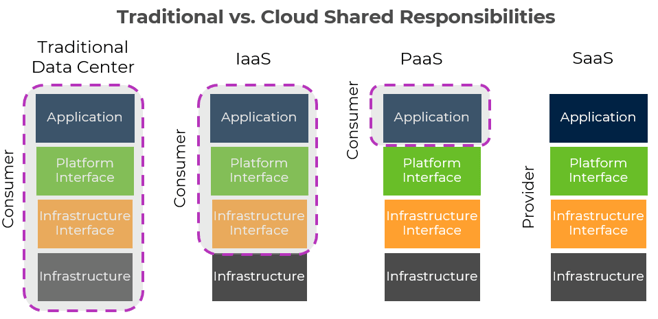In the energy industry, many companies have started or are planning their journey into the cloud (see related blog: Why It’s Time to Move Your Business Systems to the Cloud). A topic that is frequently overlooked is the advantage of having disaster recovery (DR) in the cloud. While it may not be a “sexy” topic, it is a critical one, as the potential impacts of an outage in the energy industry (e.g., trading systems, inventory, operations) can have major disruptions to operations and financials. The importance of DR may be clear, but many companies have not explored the differences between DR in the cloud vs. a traditional data center. This understanding is fundamental to planning for success in the cloud. Here are five key differences between disaster recovery in the cloud vs. traditional datacenters.
1. The cloud offers flexibility for DR that just wasn’t possible in a datacenter
Gone are the days when a DR strategy was merely a secondary data center in which to failover. Cloud DR is advantageous as it is not a hardware-focused approach where large up-front investments must be made for an additional datacenter, power, and cooling. In the cloud, DR is used to develop fast, agile, and secure solutions to recover from disasters. Unlike traditional datacenters, an application that fails in the cloud can be quickly provisioned in a different availability zone (AZ, comparable to a single datacenter) or a different region (composed of multiple AZs within a defined area). Disaster recovery in the cloud can now be done quickly and without the high capital costs of a secondary datacenter. The benefit of this is that when a natural disaster hits a region, the applications can continue to function without interruption.
2. DR responsibility shift
In traditional IT models, a company is solely responsible for all components of a system (from the application to the infrastructure); in the cloud, the customer and the cloud provider share responsibilities. The cloud provider is responsible for the high availability of the software application (SaaS), platform (PaaS) and infrastructure (IaaS) depending on the service model that was selected. It is important to note that even though the cloud provider holds certain responsibilities the companies/cloud customers are still accountable for planning an effective disaster recovery strategy. When devising an effective DR cloud strategy, the potential points of failure in the application, platform or infrastructure level must be considered. The diagram below depicts a comparison between the responsibilities of the cloud provider and the customer in a traditional application and in the cloud.

3. Environments can be designed to be self-healing
The cloud provides an opportunity to leverage tools that create a self-healing system that can recover from failures quickly and efficiently. Instances can be quickly provisioned or pre-provisioned in the event of a disaster. Data can be recovered from backups or synched to the pre-provisioned instances prior to the disaster and native cloud tools can be used for monitoring and alerting when there is a failure. The cloud enables teams to set up a disaster recovery strategy that self-heals, leveraging automation to streamline processes and reduce manual steps along with human error during the recovery time.
4. DR Tests can be automated and executed with very little pain
A benefit of being in the cloud is the ease of deploying quickly; this allows for testing to be executed by a handful of people. Planning for every conceivable failure may be difficult, but running numerous tests to validate that the DR strategy has accounted for all points of failure, and that the system is self-healing as expected can be easy thanks to the flexibility the cloud provides. A few test scenario examples include:
- Database or application goes down due to a manual user error (application-level failure)
- A cloud provider error makes the cloud environment in a given AZ unavailable (platform-level failure)
- A natural disaster takes down an AZ (infrastructure-level failure)
5. Costs is a factor, but not the biggest one
Understanding cost when employing a cloud DR solution is extremely important, but the flexibility of the cloud means that the cost can be managed in a way that is not possible in a traditional data center scenario. A cost vs. benefit analysis that assesses the technical costs of employing the solution against the recovery time objectives (RTOs), recovery point objectives (RPOs), and risk impact is imperative to develop a cost-effective and dependable strategy.
Major factors that drive costs include:
- Having single-AZ, multi-AZ or multi-region architectures
- Use of pre-provisioned instances and frequency of data replication
Major benefits include:
- Having redundancy at different levels
- Flexibility and agility; not requiring large up-front capital costs such as hardware, secondary datacenter, or large dedicated DR teams
- Control over costs: pay only for what is necessary
In Summary
In a world where agility and resiliency are essential requirements for companies, the question of disaster recovery is paramount for companies in the energy industry. Five essential differences between DR in a traditional datacenter vs. in the cloud include: the flexibility, the DR responsibility shift, self-healing environments, automated DR tests and cost factors. Understanding these differences and benefits upfront is the key to creating an effective migration plan. In our next blog, we will explore how to design and implement a DR plan, applying these differences and benefits. Check back later for more info.
At Veritas Total Solutions, we are experienced in cloud transformation. We offer a range of technology solutions across the business spectrum including disaster recovery cloud migration. If you are interested in learning more about our specific capabilities, contact us or subscribe to our blog to stay connected.

